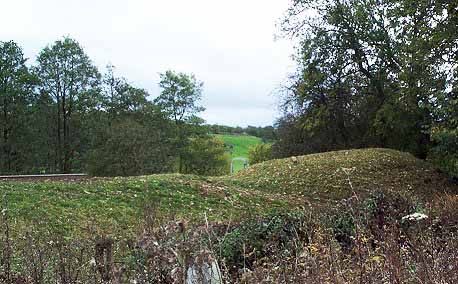Little Hereford
The enigmatic earthworks next to Little Hereford church have perturbed archaeologists for some years. Finally an answer to their questions may be postulated through historical research. Initially, during the reign of Edward the Confessor, Little Hereford and Berrington were part of the demesne of Richard Fitz Scrope of Burford barony and Richards Castle. Before 1103 his son, Osbern Fitz Richard, granted these places to Bernard Neufmarché together with his daughter Agnes who was also granddaughter of King Gruffydd ap Llywelyn of Gwynedd (d.1064). In 1121 Agnes managed to dispossess her son, Mahel, and the lordship of Brecon was passed by King Henry I to his friend Miles Gloucester together with the hand of Agnes’ daughter, Sibyl Neufmarché. Simultaneously on 10 April 1121 it was confirmed that the bishop of Hereford had granted Little Hereford and Ullingswick to Walter Durand, the father of Miles Gloucester, for the service of two knights. Before 1123 Walter in turn granted Little Hereford to his son Miles and daughter in law, Sibyl Neufmarché. Miles later exchanged the vill for Barnsley in Gloucestershire, granting Little Hereford to his nephew, William Mara, for the service of two knights. It is possible that William constructed a little fortress next to the church at this point as his caput. Otherwise the minute motte and bailey structure is the work of King Stephen in 1139.
In late September 1139 Miles Gloucester rebelled against King Stephen and attacked Hereford castle. In reply, during December 1139, Stephen came to Little Hereford with an army. Presumably the king himself resided at the motte-like structure nearest the church, whilst his army made use of the flat ground bounded by streams and banks to the east. The king (always itinerant) and more importantly his army probably stayed at Little Hereford for a period of three or four months, only apparently abandoning the site in February 1140 when Hereford castle finally fell to Miles Gloucester after a period of trench warfare. Miles had used every trick in the book to attack the castle while the king sat inactive with his army at Little Hereford. He had bombarded Hereford castle with artillery set up in the cathedral tower and sent zig-zag saps through the cathedral cemetery towards the castle, with the soldiers throwing out the bodies of the monks as sandbags as their advance inched forwards. Stephen’s answer to all this was to take the oaths of fealty of those he could in Herefordshire and to ‘make a treaty’ at his camp of Little Hereford on 3 December. The king does not appear to have stayed constantly at Little Hereford, but the unused Hereford relief army seems to have sat inactive in the fortified field east of the church and ‘castle’ for a long time. It was probably during his sojourn at Little Hereford that the king decided to make the grant of Herefordshire to Earl Robert Beaumont of Leicester. The actual deed was witnessed by Earl William of Lincoln and Earl William Aubigny of Buckenham castle at Newton just north of Leominster and conveniently near to Little Hereford. With the fall of Hereford castle the king apparently simply departed from Little Hereford, his purpose unaccomplished. A century later Reginald Mara was recorded as holding two knights’ fees at Little Hereford from the descendant of Miles Gloucester who in turn held the land from the bishop of Hereford.
Interestingly, probably a little after the Anarchy, William Mara, probably in the late twelfth century, granted the prior of St John's of Brecon permission to build upon his land of Little Hereford the pool of Berrington mill, on a yearly render of three pounds of wax for himself for life and two pounds for his heirs. This grant probably accounts for the pool and earthworks north of the camp site towards the main road.
The earthworks at Little Hereford appear to be a small motte between the church and the River Teme. Next to this on the east side lies a small inner bailey. A bank on the north side of this ‘bailey’ could have been the entrance. East of this ‘fortress’ is a large irregular area bounded by banks which are pronounced in some places. On the south side is the River Teme and two small tributary streams form the east and west boundaries. The whole area being roughly triangular. To the north of this there is a bank and ditch which appears to connect to two streams which are now dry. This northern area is very confused with low banks and hollows. It quite likely represents the mill pond of nearby Berrington as permitted by William Mara. North of the mill pond again is the track of the old Tenbury to Wooferton railway line and north of this again is the Leominster to Bewdley Canal, the construction of which might have affected the drainage pattern of the site.
